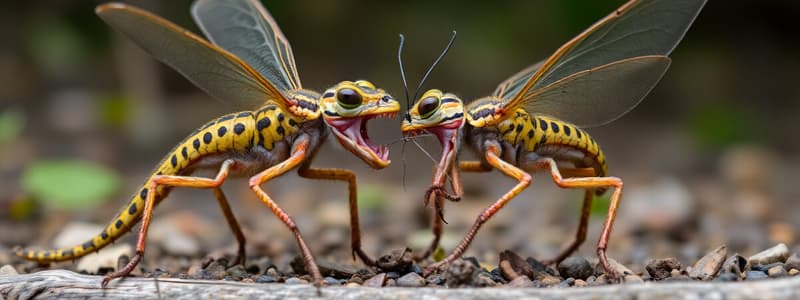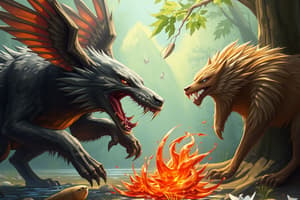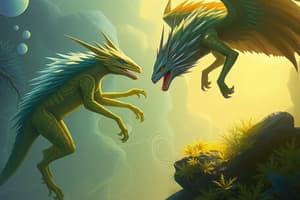Podcast
Questions and Answers
Elephants cooperate to raise their young and watch for ______.
Elephants cooperate to raise their young and watch for ______.
predators
Squirrel monkeys benefit by living in groups and cooperating as they hunt for ______.
Squirrel monkeys benefit by living in groups and cooperating as they hunt for ______.
food
In a predator-prey relationship, the ______ eats another organism.
In a predator-prey relationship, the ______ eats another organism.
predator
The osprey is an example of a predator that catches ______.
The osprey is an example of a predator that catches ______.
Predators help prevent prey populations from growing too ______ for the ecosystem.
Predators help prevent prey populations from growing too ______ for the ecosystem.
Trees compete for ______, which can affect their growth.
Trees compete for ______, which can affect their growth.
The shade from tall trees can slow the growth of ______ trees.
The shade from tall trees can slow the growth of ______ trees.
Wolves compete with ______ for meat from animals they kill.
Wolves compete with ______ for meat from animals they kill.
Cooperative relationships can be found in many different ______ across the world.
Cooperative relationships can be found in many different ______ across the world.
Competition occurs when two or more organisms need the same resource at the same ______.
Competition occurs when two or more organisms need the same resource at the same ______.
The relationship between barbel fish and hippos is a type of ______.
The relationship between barbel fish and hippos is a type of ______.
In a commensalism relationship, one species benefits while the other is ______.
In a commensalism relationship, one species benefits while the other is ______.
Epiphytes grow on the trunks of trees and absorb their nutrients from the ______.
Epiphytes grow on the trunks of trees and absorb their nutrients from the ______.
In a parasitism relationship, the ______ benefits while the host is harmed.
In a parasitism relationship, the ______ benefits while the host is harmed.
The hunting wasp's larvae act as a ______ when they consume the paralyzed spider.
The hunting wasp's larvae act as a ______ when they consume the paralyzed spider.
A symbiotic relationship in which both partners benefit is called ______.
A symbiotic relationship in which both partners benefit is called ______.
Clownfish receive protection from predators thanks to their relationship with ______.
Clownfish receive protection from predators thanks to their relationship with ______.
The relationship between trees and epiphytes involves obtaining more living space and ______.
The relationship between trees and epiphytes involves obtaining more living space and ______.
One example of a parasitic relationship is when a ______ lays its eggs in a spider's body.
One example of a parasitic relationship is when a ______ lays its eggs in a spider's body.
Symbiotic relationships often involve an exchange of ______.
Symbiotic relationships often involve an exchange of ______.
Flashcards
Symbiosis
Symbiosis
A close, long-term relationship between two species that usually involves an exchange of food or energy.
Commensalism
Commensalism
A symbiotic relationship that benefits one species but does not harm or benefit the other.
Parasitism
Parasitism
A symbiotic relationship where one species benefits and the other is harmed.
Mutualism
Mutualism
Signup and view all the flashcards
Parasite
Parasite
Signup and view all the flashcards
Host
Host
Signup and view all the flashcards
Epiphytes
Epiphytes
Signup and view all the flashcards
Barbel Fish
Barbel Fish
Signup and view all the flashcards
Hippos
Hippos
Signup and view all the flashcards
Hunting Wasp Larvae
Hunting Wasp Larvae
Signup and view all the flashcards
Cooperative Relationships
Cooperative Relationships
Signup and view all the flashcards
Competitive Relationships
Competitive Relationships
Signup and view all the flashcards
Predator-Prey Relationships
Predator-Prey Relationships
Signup and view all the flashcards
Predator
Predator
Signup and view all the flashcards
Prey
Prey
Signup and view all the flashcards
Carrying Capacity
Carrying Capacity
Signup and view all the flashcards
Squirrel Monkeys Cooperation
Squirrel Monkeys Cooperation
Signup and view all the flashcards
Tree Competition
Tree Competition
Signup and view all the flashcards
Wolves and Ravens Competition
Wolves and Ravens Competition
Signup and view all the flashcards
Ecosystem Relationships
Ecosystem Relationships
Signup and view all the flashcards
Study Notes
Lesson 2: Interactions Within Ecosystems
- Objective: Predict patterns of interactions among organisms across multiple ecosystems.
- Entry Card (Interactive Presentation): Students answer questions regarding the relationship between species (e.g., cleaner shrimp and moray eel).
- Symbiosis:
- A close, long-term relationship between two species that often involves an exchange of food or energy.
- Barbel fish and hippos have a symbiotic relationship where the fish follow and groom the hippo to feed on parasites and the hippo benefits from having any parasites removed from its mouth.
- Symbiotic relationships occur when two organisms live in direct contact and form a relationship.
Types of Symbiotic Relationships
-
Commensalism: A symbiotic relationship that benefits one species but does not harm or benefit the other.
- Epiphytes grow on tree trunks, benefiting from increased sunlight and living space without harming the trees.
-
Parasitism: A symbiotic relationship that benefits one species and harms the other.
- The hunting wasp larva is a parasite. The female wasp stings a spider to paralyze it, lays eggs in its body, the eggs hatch into larvae and consume the spider.
-
Mutualism: A symbiotic relationship in which both partners benefit.
- Clownfish and sea anemones live in tropical coral reefs. Clownfish receive protection from predators, and the anemone receives energy from the clownfish's waste.
Other Relationships in Ecosystems
-
Cooperative Relationships:
- Elephants cooperate to raise their young and watch for predators.
- Squirrel monkeys cooperate to live in groups, hunt, and watch for predators.
-
Predator-Prey Relationships:
- Predators (e.g., osprey) eat prey (e.g., fish). These relationships help regulate prey populations keeping the ecosystem healthy.
-
Competitive Relationships:
- Organisms compete for resources (e.g., sunlight, water, food). This can be seen with Trees competing for sunlight or Wolves and ravens competing over carcasses.
Homework
- Investigation: Examine relationships in communities and write observations about characteristics of the relationships.
- Lesson Check: Conduct a lesson check on interactions within ecosystems.
Studying That Suits You
Use AI to generate personalized quizzes and flashcards to suit your learning preferences.




